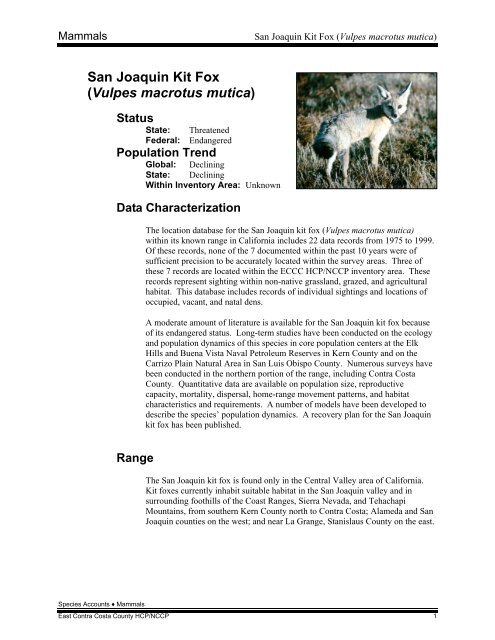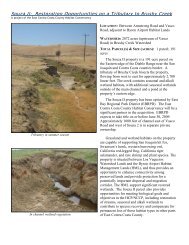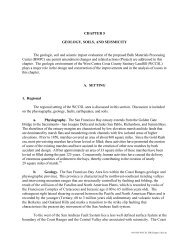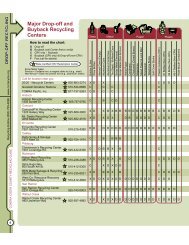San Joaquin Kit Fox (Vulpes macrotus mutica) - Contra Costa County
San Joaquin Kit Fox (Vulpes macrotus mutica) - Contra Costa County
San Joaquin Kit Fox (Vulpes macrotus mutica) - Contra Costa County
- No tags were found...
You also want an ePaper? Increase the reach of your titles
YUMPU automatically turns print PDFs into web optimized ePapers that Google loves.
Mammals<strong>San</strong> <strong>Joaquin</strong> <strong>Kit</strong> <strong>Fox</strong> (<strong>Vulpes</strong> <strong>macrotus</strong> <strong>mutica</strong>)BehaviorDen Use<strong>San</strong> <strong>Joaquin</strong> kit foxes use numerous dens throughout the year. They are used fortemperature regulation, shelter from inclement weather, reproduction, and escapefrom predators. Hall (1983) documented a family of 7 kit foxes that used 43 densin 1 year, while 1 other individual used 70 dens (K Ralls, pers. comm. inWilliams et al. 1998). Koopman et al. (1998) found that individual foxes withinthe Naval Petroleum Reserves use an average of 11.8 different dens each year,and den use does not differentiate between sexes. The number of dens usedvaried among seasons, with more dens used during the dispersal season thanduring the breeding or pup-rearing seasons. On average, kit foxes used anindividual den 10% of the time throughout the year, but favored dens were used32% of the time. Approximately 50% of the dens used by a kit fox in a 1-yearperiod had not been used by that fox during the previous year. Male and femalepups up to 18 months of age denned equally with either adult parent. Theydenned with siblings for up to 21 months of age. Radio telemetry studies of kitfox movement on the Carrizo Plain Natural Area (White and Ralls 1993) indicatethat foxes use individual dens for an average of 3.5 days before moving to adifferent den. Den changes are believed to be primarily in response to a need toavoid coyotes, although local depletion of prey and increases in external parasitesin the dens may also influence this behavior (Egoscue 1956 in Williams et al.1998).Movement<strong>Kit</strong> foxes may range up to 20 miles at night (Girard 2001) during the breedingseason and somewhat less (6 miles) during the pup-rearing season. Home rangesvary from less than 1 square mile up to approximately 12 square miles (Knapp1978, Spiegel and Bradbury 1992, White and Ralls 1993). The home ranges ofpairs or family groups of kit foxes generally do not overlap (White and Ralls1993). This behavior may be an adaptation to periodic drought-induced scarcityin prey abundance.Social StructureGenetic and field studies of kit foxes on the Carrizo Plains Natural Area (Ralls etal. 2001) showed that foxes living in adjacent home ranges tended to be moreclosely related than foxes from more distant home ranges. This pattern emergedlargely because females on adjacent home ranges were often closely related.<strong>Fox</strong>es that shared the same den were usually members of the same social group,but occasionally foxes from different social groups shared dens, possibly duringpair formation. <strong>San</strong> <strong>Joaquin</strong> kit foxes can maintain enduring social relationshipswith adult offspring or siblings that have dispersed to new home ranges andfound a mate.Ecological Relationships<strong>San</strong> <strong>Joaquin</strong> kit foxes prey upon a variety of small mammals, ground-nestingbirds, and insects. They are in turn subject to predation or killing by such speciesas coyote, non-native red foxes, domestic dog, eagles, and large hawks (HallSpecies Accounts ♦ MammalsEast <strong>Contra</strong> <strong>Costa</strong> <strong>County</strong> HCP/NCCP 5
Mammals<strong>San</strong> <strong>Joaquin</strong> <strong>Kit</strong> <strong>Fox</strong> (<strong>Vulpes</strong> <strong>macrotus</strong> <strong>mutica</strong>)1983, Berry et al. 1987, Ralls and White 1995). White et al. (2000) determinedthat coyotes were responsible for 59% of kit fox deaths during a 4-year telemetrystudy at Camp Roberts in southern Monterey <strong>County</strong>.ThreatsLoss, fragmentation, and degradation of habitat by agricultural, urban, andindustrial development continues to decrease the remaining habitat and carryingcapacity of <strong>San</strong> <strong>Joaquin</strong> kit foxes throughout its range. Livestock grazing is notthought to be detrimental to kit foxes (Morrell 1975, Orloff et al. 1986), but itmay affect the number of prey species available, depending on the intensity ofgrazing (Williams et al. 1998). In some areas, livestock grazing may benefit kitfoxes by reducing shrub cover and maintaining grassland habitat.Continued fragmentation of habitat is a serious threat to this species. Increasingisolation of populations and social groups through habitat degradation andbarriers to movement, such as aqueducts and busy highways, can limit dispersalto and habitation of existing and former lands. This isolation also favorsinbreeding depression in populations, as well as making the smaller populationssusceptible to extinction from stochastic environmental events such as droughts,flooding, fire, and periodic declines in prey abundance. Invasion of fragmented,occupied kit fox habitat by coyotes, red foxes, and feral dogs can contribute toincreased mortality of kit foxes.The use of pesticides to control rodents and other pests also threatens kit fox insome areas, either directly through poisoning or indirectly through reduction ofprey abundance. Historically, measures such as hunting and rodenticides havebeen used extensively in the inventory area to control rodents and reduceconflicts with livestock. This has greatly decreased the populations of thesespecies, reducing prey availability for their predators. In 1975, California groundsquirrel, which is the main prey item for <strong>San</strong> <strong>Joaquin</strong> kit fox in <strong>Contra</strong> <strong>Costa</strong><strong>County</strong>, was thought to have been eradicated countywide after extensive rodenteradication efforts (Bell et al. 1994; U.S. Fish and Wildlife Service 1998).California ground squirrel populations have been increasing in <strong>Contra</strong> <strong>Costa</strong><strong>County</strong> since then; however, their abundance may still limit <strong>San</strong> <strong>Joaquin</strong> kit foxpresence and abundance in the eastern portion of the <strong>County</strong> (Orloff pers.comm.).Conservation and ManagementThe <strong>San</strong> <strong>Joaquin</strong> kit fox is listed as both state and federally endangered. Arecovery plan for this species was completed in 1983 that outlines objectives tohalt the decline of the species and increase population sizes above the 1981 level(Williams et al. 1998). Subsequent conservation actions have includedacquisition of important habitat by the U.S. Bureau of Land Management (BLM),California Department of Fish and Game (CDFG), California EnergyCommission, Bureau of Reclamation, U.S. Fish and Wildlife Service (USFWS),and Nature Conservancy. Substantial long-term research has been conducted onSpecies Accounts ♦ MammalsEast <strong>Contra</strong> <strong>Costa</strong> <strong>County</strong> HCP/NCCP 6
Mammals<strong>San</strong> <strong>Joaquin</strong> <strong>Kit</strong> <strong>Fox</strong> (<strong>Vulpes</strong> <strong>macrotus</strong> <strong>mutica</strong>)populations in the Naval Petroleum Reserves and in the Carrizo Natural Area insouthern California. These studies have provided important information on kitfox habitat requirements, behavior, demographics, and threats.In 1998, a recovery plan for upland species of the <strong>San</strong> <strong>Joaquin</strong> Valley wascompleted (Williams et al. 1998), which included a revised recovery strategy forthe <strong>San</strong> <strong>Joaquin</strong> kit fox. The goal of this recovery plan is to maintain a viablemetapopulation of kit foxes on private and public lands throughout it’s the plan’sgeographic range. This will include preservation of existing core and satellitepopulations. Areas where core populations are found include the Carrizo PlainNatural Area in <strong>San</strong> Luis Obispo <strong>County</strong>; the natural lands of western Kern<strong>County</strong>, including the Naval Petroleum Reserves, the Lokern Natural Area, andadjacent natural lands inhabited by kit foxes; and the Ciervo-Panoche NaturalArea of western Fresno and eastern <strong>San</strong> Benito Counties. Camp Roberts and FortHunter Liggett also provide important habitat for kit foxes in the Salinas andPajaro river watersheds. Additional lands in the <strong>San</strong> <strong>Joaquin</strong> Valley that have kitfoxes or the potential to have them include refuges and other lands managed bythe CDFG, California Department of Water Resources, Center for Natural LandsManagement, Lemoore Naval Air Station, Bureau of Reclamation, and USFWS,as well as various private lands in these areas. While kit foxes have beendocumented in numerous locations in East <strong>Contra</strong> <strong>Costa</strong> <strong>County</strong>, no conservationareas were identified for this species in the 1998 recovery plan. However, therecovery plan identifies the protection of existing kit fox habitat in the northernportion of its range and protection of existing connections between habitat in<strong>Contra</strong> <strong>Costa</strong> <strong>County</strong> and habitat farther south as primary recovery actions.Status Assessment<strong>San</strong> <strong>Joaquin</strong> kit foxes are known to occur within the ECCC HCP/NCCPinventory area, with greater numbers occurring in the southern portion of thearea. However, compared with populations in southern California, little is knownabout the ecology and habitat needs of kit foxes in the northern part of theirrange. Researchers have consistently indicated that the behavioral ecology of kitfoxes in this region is poorly known and may be different from the ecology offoxes in the southern part of their range (Laughrin 1970, Swick 1973, Morrell1975, Orloff et al. 1986, Sproul and Flett 1993, Bell 1994). The northernpopulations of kit foxes appear to use different prey (ground squirrels instead ofkangaroo rats), and their denning habitat appears different (Orloff et al. 1986). Inaddition, habitat (ground cover, dominant vegetation, land use practices, rainfall,and in some cases relief) is substantially different in the north than in the south,where kit foxes are more abundant and well studied. Because of thesedifferences, some geographic differences may exist in the demographiccharacteristics of these populations. However, the threats of habitat loss;degradation and fragmentation; predation by coyotes, red foxes, feral dogs, andother predators; and vehicular mortality are likely to be comparable in bothregions of their range.Species Accounts ♦ MammalsEast <strong>Contra</strong> <strong>Costa</strong> <strong>County</strong> HCP/NCCP 7
Mammals<strong>San</strong> <strong>Joaquin</strong> <strong>Kit</strong> <strong>Fox</strong> (<strong>Vulpes</strong> <strong>macrotus</strong> <strong>mutica</strong>)Modeled Species DistributionModel DescriptionAssumptions1. The following land cover types were considered core habitat for the <strong>San</strong><strong>Joaquin</strong> kit fox:• Annual grassland suitable for all kit fox activities including foraging,denning, shelter and movement corridors that is connected to known kit foxmovement routes;• Oak savanna contiguous with annual grassland;• Alkali grassland within annual grassland;• Seasonal wetland within annual grassland or oak savanna;• Ruderal areas within annual grassland or oak savanna; and• All wind turbine areas within annual grassland.2. The following land cover types were considered low use habitat for <strong>San</strong><strong>Joaquin</strong> kit fox:• Cropland, pasture, and orchard land cover types within 1 mile of core habitatas defined above;• Ruderal areas contiguous with low-use cropland, pasture, or orchard habitat;and• 100-feet from suitable core habitat into oak woodlands.3. Grassland and oak savanna patches isolated from large contiguous tracts ofannual grassland by oak woodland or chapparal/scrub were considered nonhabitat.RationaleCore Habitat: In the northern part of its range (including <strong>Contra</strong> <strong>Costa</strong> <strong>County</strong>),where most habitat on the valley floor has been eliminated, kit foxes now occurprimarily in foothill grasslands (Swick 1973, Hall 1983, Williams et al. 1998),valley oak savanna and alkali grasslands (Bell 1994). They prefer habitats withloose-textured soils (Grinnell et al 1937, Hall 1946, Egoscue 1962, Morrell1972), suitable for digging, but occur on virtually every soil type. Dens aregenerally located in open areas with grass or grass and scattered brush, andseldom occur in areas with thick brush (Morrell 1972). Preferred sites arerelatively flat, well-drained terrain (Williams et al. 1998, Roderick and Mathews1999). They are seldom found in areas with shallow soils due to high watertables (McCue et al. 1981) or impenetrable bedrock or hardpan layers (Morrell1975, O’Farrell and Gilbertson 1979, O’Farrell et al. 1980). However, kit foxesmay occupy soils with a high clay content where they can modify burrow dug byother animals such as ground squirrels (Spermophilus beeychii) (Orloff et al.1986).Species Accounts ♦ MammalsEast <strong>Contra</strong> <strong>Costa</strong> <strong>County</strong> HCP/NCCP 8
Mammals<strong>San</strong> <strong>Joaquin</strong> <strong>Kit</strong> <strong>Fox</strong> (<strong>Vulpes</strong> <strong>macrotus</strong> <strong>mutica</strong>)The geographical separation of suitable and unsuitable habitat of annualgrassland and oak savanna was based on the location of large tracts of oakwoodland separating large contiguous tracts of these land cover types fromsmaller isolated patches at higher elevations to the west. While kit foxes mayoccasionally use oak woodland habitat, at least along the margins adjacent tocore grassland habitat (Orloff, pers. comm.), they are not likely to frequently passthrough these areas due to higher predation potential from other canids (coyotes,gray foxes, red foxes) and reduced prey availability. Isolated patches ofgrassland and oak savanna beyond these oak woodland tracts were thereforeconsidered not suitable habitat for this species.Low Use Habitat: <strong>San</strong> <strong>Joaquin</strong> kit foxes also less frequently occur adjacent toand forage in tilled and fallow fields and irrigated row crops (Bell 1994,Williams et al. 1997). These foxes will den within small parcels of native habitatthat is surrounded by intensively maintained agricultural lands (Knapp 1978) andadjacent to dryland farms (Jensen 1972, Orloff et al. 1986, Williams et al. 1998).<strong>Kit</strong> foxes are known to use agricultural areas within the inventory area in theseways.Model ResultsFigure2 shows the modeled potential habitat of the <strong>San</strong> <strong>Joaquin</strong> kit fox within theECCC HCP/NCCP inventory area. The habitat includes approximately twothirdsof the inventory area and is primarily located within the low elevationgrassland areas between the agricultural/urban areas in the east and north and thehigher elevation foothill areas around Mt. Diablo to the west. The documentedoccurrences of <strong>San</strong> <strong>Joaquin</strong> kit foxes in this area correspond well to locationswithin the modeled core area habitat.Literature CitedBell, H. 1994. Analysis of habitat characteristics of <strong>San</strong> <strong>Joaquin</strong> kit fox in itsnorthern range. Master’s Thesis, California State University, Hayward.Berry, W. H., J. H. Scrivner, T. P. O’Farrell, C. E. Harris, R. T. Kato, and P. M.McCue. 1987. Sources and rates of mortality of the <strong>San</strong> <strong>Joaquin</strong> kit fox,Naval petroleum reserve #1, Kern <strong>County</strong>, California, 1980-1986. U. S.Dept. of Energy Topical Report, EG&G/EM <strong>San</strong>ta Barbara OperationsReport No. EGG 10282-2145. 34 pp.Clark, Jr., H. O., D. A. Smith, B. L. Cypher, and P. A. Kelly. 2003. Detectiondog surveys for <strong>San</strong> <strong>Joaquin</strong> kit foxes in the northern range. Prepared forPacific Gas & Electric Company Technical and Ecological Services, <strong>San</strong>Ramon, CA.Cypher, B. L., G. D. Warrick, M. R. M. Otten, T. P. O’Farrell, W. H. Berry, C. E.Harris, T. T. Kato, P. M. McCue, J. H. Scrivner, B. W. Zoellick. 2000.Species Accounts ♦ MammalsEast <strong>Contra</strong> <strong>Costa</strong> <strong>County</strong> HCP/NCCP 9
Mammals<strong>San</strong> <strong>Joaquin</strong> <strong>Kit</strong> <strong>Fox</strong> (<strong>Vulpes</strong> <strong>macrotus</strong> <strong>mutica</strong>)Population dynamics of <strong>San</strong> <strong>Joaquin</strong> kit foxes at the naval petroleumreserves in California. Wildlife Monographs 145:1–43.Duke, R, R. Hopkins and S. E. Townsend. 1997. Distribution of the <strong>San</strong> <strong>Joaquin</strong>kit fox in the north part of its range. H. T. Harvey & Associates. March 13,1997. Project 673.11. 32 pp.Egoscue, H. J. 1962. Ecology and life history of the kit fox in Tooele <strong>County</strong>,Utah. Ecology 43:481–497.Girard, I. 2001. Field cost of activity in the kit fox, <strong>Vulpes</strong> macrotis.Physiological and Biochemical Zoology 74(2):191–202.Grinnell, J., J. S. Dixon, and J. M. Linsdale. 1937. Fur-Bearing Mmammals ofCalifornia. Univ. California Press, Berkeley. Vol. 2, xiv + 377-777.Hall, E. R. 1946. Mammals of Nevada. Univ. California Press, Berkeley. xi +710 pp.Hall, Jr., F. A. 1983. Status of the <strong>San</strong> <strong>Joaquin</strong> kit fox, <strong>Vulpes</strong> macrotis <strong>mutica</strong>,at the Bethany Wind Turbine Generating Project site, Alameda <strong>County</strong>,California. California Department of Fish and Game. 36pp.Jensen, C. C. 1972. <strong>San</strong> <strong>Joaquin</strong> <strong>Kit</strong> <strong>Fox</strong> Distribution. Bureau of Sport Fish andWildlife, Div. Wildlife Serv., Sacramento, Ca. 22 pp.Knapp, D. K. 1978. Effects of agricultural development in Kern <strong>County</strong>,California, on the <strong>San</strong> <strong>Joaquin</strong> kit fox in 1977. Final Report, Project E-1-1,Job V-1.21, Non-Game Wildlife Investigations, California Department ofFish and Game, Sacramento, California.Koopman, M. E., B. L. Cypher, and J. H. Scrivner. 2000. Dispersal patterns of<strong>San</strong> <strong>Joaquin</strong> kit foxes (<strong>Vulpes</strong> macrotis <strong>mutica</strong>). Journal of Mammalogy81(1):213–222.Koopman, M. E., J. H, Scrivner, and T. T. Kato. 1998. Patterns of Den Use by<strong>San</strong> <strong>Joaquin</strong> <strong>Kit</strong> <strong>Fox</strong>es. Journal of Wildlife Management 62(1): 373–379.Laughrin, L. 1970. <strong>San</strong> <strong>Joaquin</strong> kit fox, its distribution and abundance.California Dept. of Fish and Game, Wildlife Management Branch.Administrative Report 70-2, Sacramento. 20pp.McCue, P., T. Kato, M. L. Sauls, T. P. O’Farrell. 1981. Inventory of <strong>San</strong><strong>Joaquin</strong> kit fox on land proposed as Phase II, Kesterson Reservoir, Merced<strong>County</strong>, California. Topical Report EGG 1183-2426, EG&G, <strong>San</strong>ta BarbaraOperations, U.S. Department of Energy, Goleta, California.McGrew, J. C. 1979. <strong>Vulpes</strong> macrotis. Mammalian species 123:1–6.Species Accounts ♦ MammalsEast <strong>Contra</strong> <strong>Costa</strong> <strong>County</strong> HCP/NCCP 10
Mammals<strong>San</strong> <strong>Joaquin</strong> <strong>Kit</strong> <strong>Fox</strong> (<strong>Vulpes</strong> <strong>macrotus</strong> <strong>mutica</strong>)Morrell, S. 1975. <strong>San</strong> <strong>Joaquin</strong> kit fox distribution and abundance in 1975.Administrative Report 75-3, California Department of Fish and Game,Sacramento California. 28 pp.O’Farrell, T. P., T. Kato, P. McCue, and M. S. Sauls. 1980. Inventory of the <strong>San</strong><strong>Joaquin</strong> kit fox on BLM lands in southern and southwestern <strong>San</strong> <strong>Joaquin</strong>Valley. Final Report, ECC 1183-2400, EG&C, <strong>San</strong>ta Barbara Operations,U.S. Department of Energy, Goleta, California.O’Farrell, T. P. and L. Gilbertson 1979. Ecological life history of the desert kitfox in the Mojave desert of southern California. Final Report. U.S. Bureauof Land Management, Desert Plan Staff, Riverside, California.Orloff, S., F. Hall, and L. Spiegel. 1986. Distribution and habitat requirementsof the <strong>San</strong> <strong>Joaquin</strong> kit fox in the northern extreme of their range. Trans.West. Sect. Wildl. Soc. 22: 60–70.Ralls, K., and P. J. White. 1995. Predation on <strong>San</strong> <strong>Joaquin</strong> kit foxes by largercanids. Journal of Mammalogy 76:723–729.Ralls, K., K. L. Pilgrim, P. J. White, E. E. Paxinos, M, K. Schwartz, and R. C.Fleischer. 2001. Kinship, social relationships, and den sharing in kit foxes.Journal of Mammalogy 82(3):858–866.Roderick, P. J. and N. E. Mathews. 1999. Characteristics of natal and non-natalkit fox dens in the northern Chihuahuan Desert. Great Basin Naturalist59(3):252–258.Smith, D. A., K. Ralls, A. Hurt, B. Adams, M. Parker, B. Davenport, M. C.Smith, and J. E. Madanado. In Press. Detection and accuracy rates of dogstrained to find scats of <strong>San</strong> <strong>Joaquin</strong> kit foxes (<strong>Vulpes</strong> macrotis <strong>mutica</strong>).Animal Conservation.Spiegel, L. K. and M. Bradbury. 1992. Home range characteristics of the <strong>San</strong><strong>Joaquin</strong> kit fox in western Kern <strong>County</strong>, California. Transactions of theWestern Section Wildlife Society 28:83–92.Sproul, M. J. and M. A. Flett. 1993. Status of the <strong>San</strong> <strong>Joaquin</strong> kit fox in thenorthwest margin of its range. Transactions of the Western Section of theWildlife Society 29:61–69.Swick, C. D. 1973. Determination of <strong>San</strong> <strong>Joaquin</strong> kit fox in <strong>Contra</strong> <strong>Costa</strong>,Alameda, <strong>San</strong> <strong>Joaquin</strong>, and Tulare Counties. Special Wildlife InvestigationsProgram Report W-54-R4, California Department of Fish and Game,Sacramento, California. 14 pp.Warrick , G. D., J. H. Scrivner, and T. O’Farrell. 1999. Demographic responsesof kit foxes to supplemental feeding. Southwestern Naturalist 44(3):367–374.Species Accounts ♦ MammalsEast <strong>Contra</strong> <strong>Costa</strong> <strong>County</strong> HCP/NCCP 11
Mammals<strong>San</strong> <strong>Joaquin</strong> <strong>Kit</strong> <strong>Fox</strong> (<strong>Vulpes</strong> <strong>macrotus</strong> <strong>mutica</strong>)White, P. J. and R.Garrott. 1999. Population dynamics of kit foxes. CanadianJournal of Zoology. 77(3):486–493.White, P. J. and K. Ralls. 1993. Reproduction and spacing patterns of kit foxesrelative to changing prey availability. Journal of Wildlife Management.57(4):861–867.White, P. J., W. H. Berry, J. J. Eliason, and M. T. Hanson. 2000. Catastrophicdecrease in an isolated population of kit foxes. Southwestern Naturalist45(2):204–211.Williams, D. F., E. A. Cypher, P. A. Kelly, N. Norvell, C. D. Johnson, G. W.Colliver, and K. J. Miller. 1998. Draft Recovery Plan for Upland Species ofthe <strong>San</strong> <strong>Joaquin</strong> Valley, California. U. S. Fish and Wildlife Service, PortlandOregon. 295 pp.Zoellick, B. W., R. P. O’Farrell, P. M. McCue, C. E. Harris, and T. K. Kato.1987. Reproduction of the <strong>San</strong> <strong>Joaquin</strong> kit fox on Naval Petroleum Reserve#1, Elk Hills, California, 1980–1985. U.S. Dept. of Energy Topical Report,EG&G/EM <strong>San</strong>ta Barbara Operations Report No. EGG 10182-2144. 42 pp.Personal CommunicationsOrloff, Sue. Wildlife biologist, <strong>San</strong> <strong>Joaquin</strong> kit fox expert, and an HCP/NCPScience Advisor, Ibis Environmental Consulting, <strong>San</strong> Rafael, CA.Species Accounts ♦ MammalsEast <strong>Contra</strong> <strong>Costa</strong> <strong>County</strong> HCP/NCCP 12










